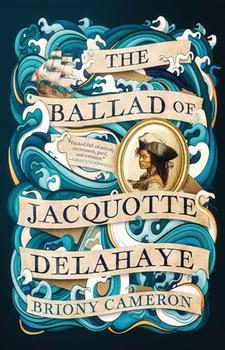Summary | Excerpt | Reviews | Beyond the Book | Read-Alikes | Genres & Themes | Author Bio

A Novel
by Briony CameronThis article relates to The Ballad of Jacquotte Delahaye
 Briony Cameron's debut novel, The Ballad of Jacquotte Delahaye, is an imagined look at the life of a female pirate captain sailing the Caribbean in the 17th century. While some of her contemporaries, like Anne Bonny and Mary Read, have become well known, Delahaye has been largely lost to history due to a lack of reliable records. Cameron acknowledges in the foreword that the narrative required many creative liberties, given the scarcity of information available about the heroine. In fact, several scholars now dispute whether she ever existed at all.
Briony Cameron's debut novel, The Ballad of Jacquotte Delahaye, is an imagined look at the life of a female pirate captain sailing the Caribbean in the 17th century. While some of her contemporaries, like Anne Bonny and Mary Read, have become well known, Delahaye has been largely lost to history due to a lack of reliable records. Cameron acknowledges in the foreword that the narrative required many creative liberties, given the scarcity of information available about the heroine. In fact, several scholars now dispute whether she ever existed at all.
What alleged details do we have about Jacquotte Delahaye? She was supposedly born in Saint-Dominique in 1630, the daughter of a Haitian mother and a French father. Her mother is believed to have died in childbirth with Jacquotte's younger brother, who was disabled. When her father was killed during a raid by the British Navy, Jacquotte took to the sea and a life of piracy in order to provide for her brother and avenge their losses.
Delahaye is said to have become a fearsome leader, attracting admirers and enemies alike. She became known for her distinct red hair, and during one particular battle, she is said to have faked her own death and temporarily assumed a male alias in order to evade her foes. This made her even more notorious within the pirating world, earning her the nickname "Back from the Dead Red." She is also thought by some to have been linked to fellow pirate Anne Dieu-le-Veut — inspiration, perhaps, for the queer love story that runs throughout Cameron's novel.
By 1656, at the age of just 26, Delahaye had amassed a crew of hundreds and led a successful mission to take control of Fort de la Roche on the Caribbean Island of Tortuga from the Spanish. She used this base to form a so-called "freebooter republic" — a safe haven for fellow pirates. She is said to have died in battle seven years later, in 1663, defending her hard-won community from invaders. Some believe this was not the end of her story, however. After all, Delahaye was known to have faked her own death once before; who's to say she didn't do it again?
Some also claim she had a daughter, Dinah Delahaye, who shared her mother's characteristic red hair. Dinah is believed to have grown into a master swordswoman and pirate captain in her own right, leading a fleet of ships and continuing her mother's legacy.
The debate surrounding the veracity of Delahaye's story is due to the fact that there are no contemporaneous primary sources that confirm her existence. Instead, her life story survived purely through the tradition of oral storytelling, passed from one generation to the next. French author Léon Treich's account of her alleged exploits from the 1940s is the most well-known written version.
Whether fact or fiction, the cultural and historical implications of Delahaye's story are vast. If true, it is hugely significant that a Haitian woman at that time was able to achieve such a level of independence. Jacquotte Delahaye is a name that deserves to be as synonymous with pirate rule as the likes of Blackbeard and Calico Jack. The Ballad of Jacquotte Delahaye sets out to bring that reality one step closer.
Galleon ship, courtesy of Pixabay
Filed under People, Eras & Events
![]() This article relates to The Ballad of Jacquotte Delahaye.
It first ran in the June 19, 2024
issue of BookBrowse Recommends.
This article relates to The Ballad of Jacquotte Delahaye.
It first ran in the June 19, 2024
issue of BookBrowse Recommends.
Your guide toexceptional books
BookBrowse seeks out and recommends the best in contemporary fiction and nonfiction—books that not only engage and entertain but also deepen our understanding of ourselves and the world around us.